Bra Liv GP group in Jönköping County in Sweden are on a digital transition journey that is now well underway. The group have moved from the traditional telephone queue and its well-known frustrations, to a digital front door that helps them to solve as many cases as possible directly. This digital transformation was made possible through the Visiba Care app, messaging and collaboration tools.
Bra Liv GP group (the Swedish equivalent of a PCN) consists of 33 practices with a total of approximately 270,000 registered patients and is owned and operated by Region Jönköping County (the Swedish equivalent of an ICS). When Bra Liv nära (a joint digital GP practice) was launched in Jönköping County in 2015, it was Sweden's, and perhaps even Europe's, first publicly funded primary care player to start offering digital healthcare appointments. Today, about 40% of people in Jönköping County have downloaded the Bra Liv nära app, which today is also the digital entry point to the 33 local GP practices. Residents simply choose their own GP practice from the list of surgeries in the app. The fact that residents have the opportunity to meet the same health practitioners digitally as well as physically, is consistent with how Bra Liv wants to work with "good and close healthcare".
The transition will contribute to ongoing high continuity of patient appointments. We know that is quality!
– Johan Carlsson, Head of Development at Bra Liv GP group

The Bra Liv Hälsan1 GP practice is one of the practices that has been a heavy user of the digital channel.
We do it for the patient; to match today's accessibility requirements. We do it for the employees; to create a better working environment. And we're doing it for the practice; so our patients don't go elsewhere.
– Ann Vikström, Head of Operations at Bra Liv Hälsan 1 GP practice
The digital route into the GP practice is just one part of a whole new way of working. Bra Liv is re-evaluating the notion that first contact with the patient has to be done by phone. Rather than a process which can result in 'telephone tennis' with multiple telephone calls, they want to work with the efficiency of an air traffic control tower.
There is a huge increase in incoming calls to GP practices around the country and there simply isn’t time for phone queues. It is a huge strain and neither the healthcare practitioners nor patients are fully satisfied, while resources are and will become even more limited.
– Ulf Österstad, doctor and general manager at Bra Liv nära
The new approach means a move away from the traditional GP practice model where new cases come in over the phone and are processed 2-3 times before being assessed and closed. The old work method requires about three full time employees per GP practice to handle all incoming calls. A call takes almost ten minutes on average and 50% of cases are not closed, but need to be re-assigned. In reality, nurses often have to spend time looking around for the doctor to ask for advice, or a doctor's appointment is booked just in case. This causes a loss in productivity, possibly using resources incorrectly and unnecessarily long waits for the patient.
Bra Liv is on a journey where they expect most cases to come in primarily via the app as messages. Their cross-functional team will need to spend extra time dealing with them initially but according to their hypothesis, in the long term, this could mean saving the time of 1-2 full time employees per GP practice. Time that can be reallocated and spent creating even better healthcare for more people.
For patients, that means that rather than being allocated a telephone appointment time slot and having to wait to be called, they can seek care and leave their history on the app in their own time. For nurses, it means that they know what the case is about before they need to start prioritising and making decisions about possible appointment booking and with whom. Sometimes a telephone consultation with a nurse is still the best option, sometimes a video call with a doctor, counsellor or physiotherapist is best. And sometimes the best thing to do is schedule a physical consultation at the GP practice as the next step.
When a GP practice transitions to the 'air traffic control tower method', there are three critical success factors identified by Bra Liv:
- Promote the app and encourage a change in behaviour
Changing the patients’ habits around how they choose to contact their GP practice can be challenging, but is absolutely key. Several of the GP practices within Bra Liv have started working by redirecting patients to the app from a message on their answering machine. The message simply provides a keypad number to select to get the app. If you select it, you get a text message with a link to Bra Liv nära (the app) and a simple process to follow. Another way to encourage a change in behaviour is to restrict GP practice telephone availability times, and redirect patients to the messaging option. Of course, finding the most appropriate methods to encourage patients in the right direction requires significant consideration. It's vital to make sure that it is done in the right way and that alternative routes, such as a telephone line specifically for seniors, are available for those who need or would prefer this. - Streamline using messaging
There are several reasons why messaging is an important part of the new approach. The fact that the information is contained in text creates opportunities for staff to get an overview, sort and prioritise patient cases. It also creates the conditions to be able to automate certain procedures, now and in the future. In addition, messages take about half as long to respond to as talking on the phone. switching to messaging rather than the telephone is to create a calmer working environment at the GP practice. - Place a cross-functional team on the front line
The team in the Bra Liv air traffic control tower consists of nurses, a doctor and possibly a physiotherapist. The role of the doctor is often advisory. The overall skillset almost always allows the case to be solved in the first instance. In addition, the team becomes a hub for sharing knowledge and increasing understanding of each other's professional roles.
The development management team at Bra Liv are confident that they are on the right path in their transformation journey, but that it will take time to change the habits of patients, and perhaps above all, their own organisation.
We see that this is a key ingredient in our goal of building close care, where we as public primary care can continue to be experienced as accessible, providing good care and quality. Patients appreciate this and we have experienced the value — not least during the pandemic. As healthcare professionals, we must dare to try new ways of working and meeting and communicating with the patient in new ways.
— Johan Carlsson


